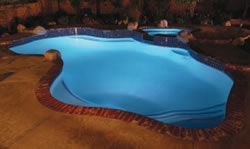
A prime example of this in recent years has been the industry's gradual shift toward LED pool lighting. LED's main benefits, low energy usage and long life, have such appeal to consumers that light manufacturers across the board have been refocusing their energies on the technology, despite considerable past investment in incandescent and fiber optics.
But while companies like Fiberstars, Pentair and Hayward are diving into the LED segment, they point out that the older technologies, some of which were considered cutting edge only a half dozen years ago, still have a place in the pool and still sell better than LEDs. Producing a bright white light is one area where LEDs can't yet compete with incandescents and halogens, a factor that's slowed their growth, say manufacturers. Opinions differ, however, on whether that, too, will soon change."I think the market is definitely heading toward LED lighting," says Barry Greenwald, president of Fiberstars, a Pleasanton, Calif., company strongly associated with fiber optics. "As LEDs have gotten progressively brighter over the past five years, they have and will continue to take a bigger and bigger market share."
Fiberstars recently added an LED line to light water features and in laminars, but Greenwald says it'll be years before LED manufacturers can produce the type of light a 150-watt metal halide lamp can.
"I don't believe there would be an LED that can get to that kind of brightness in the next 10 years," he says. "They're nowhere near that now." Paul Canavan, product manager for lighting and white goods at Hayward Pool Products, Elizabeth, N.J., sees things a little differently. "I think the next thing is for white LED lights," he says. "We're just waiting for the large manufacturers to get those LEDs up to the appropriate lumen per watt that are required for pool lighting."
O'Ryan Industries, a Vancouver, Wash., company that started out making LED lights for spas, recently introduced a line of high-density pool lights. Sales and marketing manager C.J. Haney says these lights do a very good job of lighting up certain ingrounds, depending on color of the walls (the lighter the better) and the geometry of the pool (the simpler the better).
"If you're going to put a light under a diving board on, say, a 12-by-25- or 14-by-30-foot pool, you can take the housing that's there and I can give you a 202 LED, which retails for about $400, and it's going to last 100,000 hours," she says. "That's a great marketing tool."
Bright Future
"The 30,000-foot view is that you have LED technology that is just exploding across all areas - taillights, traffic lights, now people are considering white LEDs for headlights as they continue to get brighter," Canavan says. "The real story behind all that is the life of an LED and the energy efficiency of an LED. If you consider that, in the pool business, if your standard white light is 300 watts, you're looking at LED lights that are 50, 75 watts, depending on whose fixture you're looking at. That's one-sixth [the power usage], if you go from 300 down to 50 watts."
He points to wider consumer trends such as more-fuel-efficient cars, refrigerators and even pool heaters as evidence that LED's energy-saving benefits will continue to help it grow. Conservation is in, and that's driving advances in things like LED lighting. Like anything, though, that technology comes at a cost, another factor that's keeping LEDs from overtaking more of the lighting segment than they already are, according to Canavan. "There's some economics involved there," he says. "You could load up a circuit board with a tremendous amount of LED diodes for, say, a pool light, but it would be wildly prohibitive from a cost standpoint.
"But think of plasma TVs. Five years ago they were 10 grand. Well, you know what? Today you can get them for two. It's just the evolution of the technology and mass production."
Colors And Control
While the industry waits for advancements from LED manufacturers, many are using current LED and automation technology to create pool lighting systems that some company executives say outshine their incandescent counterparts.
Pentair's first LED, the IntelliBrite, for example, takes the color-changing ability of the company's halogenbased SAm light and improves upon it by allowing homeowners to customize light shows to suit their tastes. "With LED technology you can immediately change colors," notes David MacCallum, product manager for lights and automation products at Pentair Water Pool and Spa, Sanford, N.C. "This allows homeowners to create an exciting, high-energy environment in their backyard.
"Homeowners can use a wired or wireless remote to instantly change the pool and spa lights to a solid color such as blue or green. Alternatively, they can also switch to one of our numerous color modes such as Caribbean, which will fade in and out of greens and blues. You have lots of different options when you tie these lights in with an automation system."
Hayward is also working on its LED color lighting system, ColorLogic, and will soon introduce a new version. "The current version is 2.5, and Gen 3 will continue to work as a 2.5 but it'll be 50 percent brighter," Canavan says. "But if you have a Goldline ProLogic control (which Hayward owns), and integrate that with the ColorLogic network module, you can exponentially increase the number of choices that you as the homeowner would have. That's because of the 'brains' in the ProLogic and the ColorLogic network module. You can tell each light what to do. That's brand new."
Sharing The Stage
LEDs had a small place in the pool industry in the early years of this decade, but incandescent and fiberoptic lights appeared to have a solid hold on the market. Fiber optics were seen as the best fit for customers looking to illuminate multiple elements of the pool and backyard, since a single light source could deliver illumination to multiple parts of a project.
Once the initial expense was absorbed, pool and landscape designers could, with relatively little difficulty, shine a light on a water feature or light up a pool's perimeter. Incandescent lights were familiar to builders and consumers and were making giant aesthetic strides with the advent of lights such as Pentair's SAm light for pools and SAL light for spas, both of which produced brilliant light shows when coupled with colorchanging wheels. Those technologies may not be new to the industry, but they still make up the lion's share of the pool-lighting segment.
"Approximately 90 percent of the residential pool/spa market is still using incandescent light bulb technology," says MacCallum. "LED technology is relatively new. [But] looking out into the next decade, we do expect that LED technology will be a significant player. But it's just like any other new technology - there's an adoption curve that technology follows. There are the early adopters, then there are the people who say, 'I'm going to wait and see' or 'I'm happy with what I've got.' Then over time they decide to adopt it for one reason or another." Until then at least, and perhaps beyond, you'll continue to see pools and spas with fiber-optic and incandescent lights, a group that includes quartz-halogen and other lights with filaments. "LED pool/spa lighting is our premium color pool/spa light offering and this may not fit the budget for every pool," MacCallum says.
"However, you can expect that LED pool/spa lighting will increasingly become attractive as the price of LEDs becomes more attractive." Count Canavan among those who insist incandescent lights aren't going away anytime soon.
"Incandescents are here to stay," he says. "Some people are willing to pay for upgrades, whether it's a heater or colored lights, salt, those types of things. But some people really just want the pool to swim in and they don't want to pay for all the extras."











































